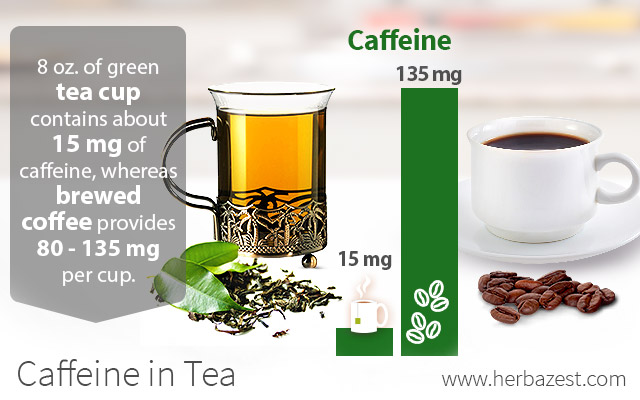Caffeine is a natural-occurring central nervous system stimulant found in various plants, such as tea plant (Camellia sinensis), coffee, cacao, cola nut, mate, and guarana. It is also added to soft beverages and many energy drinks.
Although caffeine has been consumed from various plants for thousands of years, it was first isolated from cacao beans in 1820s and named 'theine'. In plants, it works as an insecticide to repel invading pathogens. For humans, it is a magical compound offering mental alertness and energy.
Caffeine Content in Tea
Black tea contains about 40 mg of caffeine per serving, which makes it a high caffeine tea, followed by green tea, with 20 mg. However, if you are looking for a low caffeine tea, white tea is a good option, since it provides only 15 mg of caffeine per serving.
All types of tea produced from the Camellia sinensis plant contain caffeine, but its amount fluctuates among the different tea varieties, depending on several factors.
The first group of factors is related to the tea plant cultivation and processing methods:
Growing methods. Shading, plucking methods, and use of nitrogen fertilizers all affect the caffeine content.
Tea plants parts. Tea can be made of different parts of the tea plant, which affects their caffeine quantity. For example, young tea leaves and tea buds are said to contain higher amounts of caffeine as opposed to the stems and older leaves, which have less caffeine.
Processing methods. The caffeine levels in tea greatly depend on the method used to cure the leaves. Due to their fermentation process, black and oolong teas are higher in caffeine than other varieties. On the other hand, the processing of sencha, popularly known as green tea, results in high amounts of catechins but low levels of caffeine.
The second set of factors directly depends on the consumer and the method of tea brewing, which, in fact, is considered an art in many societies:
Steeping method. Most caffeine is extracted into the water during a period of five minutes of steeping with only 20% of it being extracted in the first minute. Therefore, shortening the steeping time can lessen the amount of caffeine in a cup of tea.
Type and quantity of tea leaves. The more grams of tea leaves per cup, the higher caffeine content.
Water amount and temperature. When tea is steeped in hot water, its caffeine levels are higher than in case of a tea steeped in lukewarm or cold water.
Caffeine in Tea and Coffee
There is a common belief that coffee contains more caffeine than tea. In reality, when tea and coffee are compared in their dry form, the levels of caffeine in tea leaves per gram are actually higher than in coffee. However, these values are completely reversed once tea and coffee are brewed, resulting in higher amounts of caffeine per cup in coffee.
An eight-ounce cup of green tea contains about 15 mg of caffeine, while brewed coffee provides 80 - 135 mg per cup.
Benefits of Caffeine in Tea
The reason caffeine-containing beverages are so popular is because they provide a quick energy boost. When tea caffeine content is combined with an amino acid called L-Theanine, both substances improve mental alertness and concentration, as well as athletic performance and endurance. Scientific studies suggest that a regular consumption of tea increases memory, executive function, and information-processing speed.
Another great health benefit of caffeine in tea is its fat burning action. Its consumption has been reported to enhance weight loss due to fat oxidation and thermogenesis.
Consumption of Tea
Tea consumption has not been associated with any health risks, as long as the daily intake does not exceed 400 mg as research suggests. People with certain medical conditions or taking medications are advised to consult with their physician to ensure the safety of drinking caffeine-containing beverages, such as tea. It is also worth reading the labels on other products not typically associated with containing caffeine.
Since the caffeine levels in tea are lower than in coffee after the leaves are brewed, they are believed to provide a much gentler, but longer stimulation and alertness throughout the day.
Decaffeinated Tea
Interestingly, the expensive and complicated process of decaffeination does not make tea totally caffeine free either. The amount of caffeine in decaf tea is of 1 - 2%, roughly 5 - 10 mg per cup.
THE DECAFFEINATION PROCESS ALSO REMOVES POLYPHENOLS, ASSOCIATED WITH MANY HEALTH BENEFITS OF TEA PLANT.
Additionally, the process of decaffeination is said to slightly change the flavor of the tea, and an excellent way to improve this is by flavoring it with other herbal infusions, which usually are naturally caffeine-free. Some delicious examples include hibiscus, chamomile, and many others.
Sources
- International Journal of Chemical, Environmental & Biological Sciences, The Bioactive Compounds of Tea and Decaffeinated Tea (Camellia sinensis), 2013
- Obesity Research, Body weight loss and weight maintenance in relation to habitual caffeine intake and green tea supplementation, 2005
- Oregon State University, Micronutrient Information Center | Tea
- Tea and Tea Products: Chemistry and Health-Promoting Properties, p. 25
- The Journal of Analytical Toxicology, Caffeine Content in Brewed Teas, 2008
- The Tea Book, p. 92
- Transaction on Biotechnology, Effects of Temperature and Water Steeping Duration on Antioxidant Activity and Caffeine Content of Tea, 2015
- Journal of Food Science, Distribution of Catechins, Theaflavins, Caffeine, and Theobromine in 77 Teas Consumed in the United States, 2005
- Journal of Agricultural and Food Chemistry, Factors affecting the levels of tea polyphenols and caffeine in tea leaves, 2003




